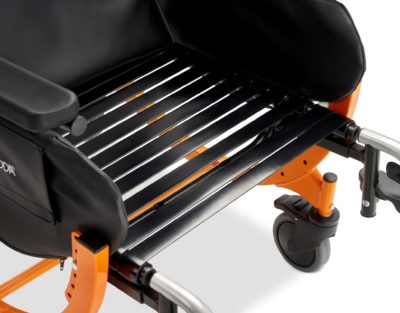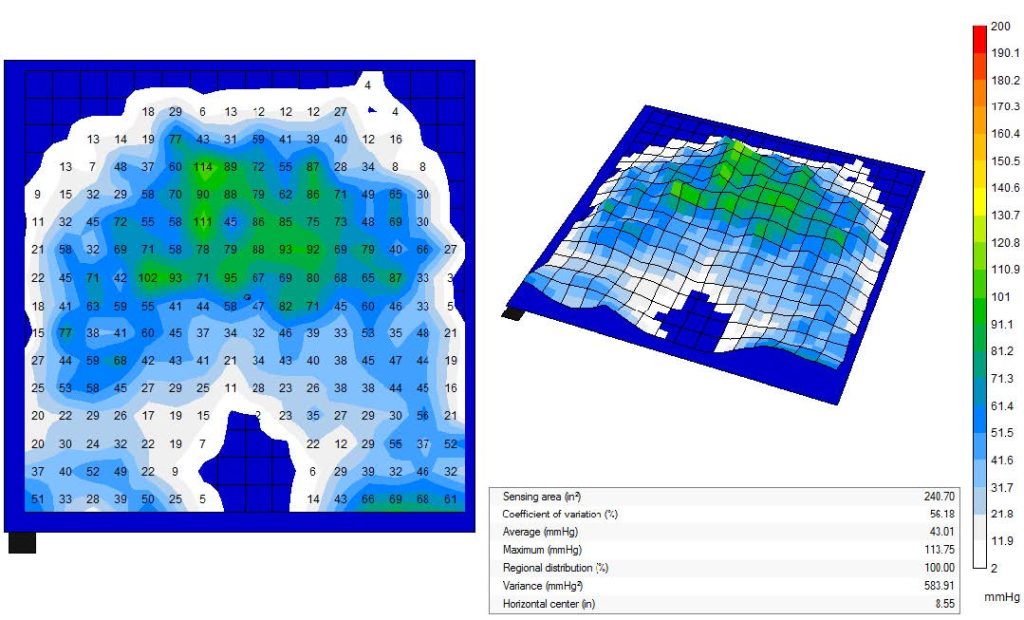Comfort Tension Seating®

Broda’s proprietary Comfort Tension Seating® conforms to the body, providing enhanced pressure redistribution and long-term seating comfort. Each strap conforms individually to the patients’ body, thus suspending the weight of the patient across multiple points. Comfort Tension Seating® works in conjunction with tilt-in-space seating system to provide therapeutic pressure relief, enhance postural support and maintain skin integrity.
The seating base used in this system is a heavy gauge polyvinyl chloride strapping installed under tension and riveted to the seating frame of the chair. With memory retention, the straps return to their original shape within seconds providing consistent seating comfort and pressure redistribution.
- Long-Term Durability
- Easy Maintenance
Long-Term Durability

The strapping used in Comfort Tension Seating® is manufactured exclusively for Broda and will retain its firmness and resiliency over an extended period. The straps are fungicide and ultraviolet protected for enhanced durability and extended lifetime.
Easy Maintenance

The straps are easy to clean off, and the chair is easily disinfected with a towel soaked in hot water and detergent. Damage to the seating surface of traditional Geri-chairs requires the purchase of expensive cushioning or whole new chairs. On Broda chairs, individual straps that are damaged can be cut and replaced on-site without taking the chair out of service for more than a few minutes.
Medical Indications for Use
Positioning
- Posterior tilt can reduce the effects of gravity on the trunk and upper body, which provides a more functional and proper upright posture
- Facilitates more practical use of the upper extremities
- Facilitates safe, effective positioning of the patient following transfer allowing adjustment of posture from the tilted position
- Eliminates shear displacement (sliding out of place) during position changes
- Posterior tilt efficiently opens the diaphragm allowing for more significant expansion of the lungs resulting in improved oxygenation, blood flow, and organ function
- Facilitates positioning for comfort, pain management and/or pain relief
Pressure Relief
- Facilitates position changes associated with pressure relief for individuals with limited range of motion
- Provides a change in position for those who cannot independently shift their weight
- Tilting the seating surface allows for repositioning which moves the weight and pressure away from the critical areas under the pelvis
- Proper repositioning improves blood flow, oxygenation, and retention of the skin tissue which is vital for maintaining skin integrity
Endurance
- Proper positioning and weight distribution increases sitting tolerance throughout the day
- Positioning the patient in an activity ready position improving the patient’s ability to socialize and engage with their surroundings
- Increase endurance for completion of activities of daily living by placing the patient in an action-ready position
- Provides proper seating alignment decreasing patient fatigue and postural deviations
- Posterior tilt enhances visual orientation, speech, alertness, and arousal
General Wellness
- Obtaining adequate posture through the use of tilt allows for improved function of the respiratory system
- Posterior tilt facilitates proper digestion and decreases the risk of aspiration and other complications of the GI Tract
- Improves physiological processes such as orthostatic hypotension, respiration, and bowel and bladder function
- Manages symptoms related to *edema (swelling) of the extremities
Caregiver Assistance
- Aids in the completion of activities of daily living; feeding, bathing, and toileting needs
- Allows for frequent repositioning of individuals throughout the day
- Improved seating comfort allows for fewer transfers during the day

